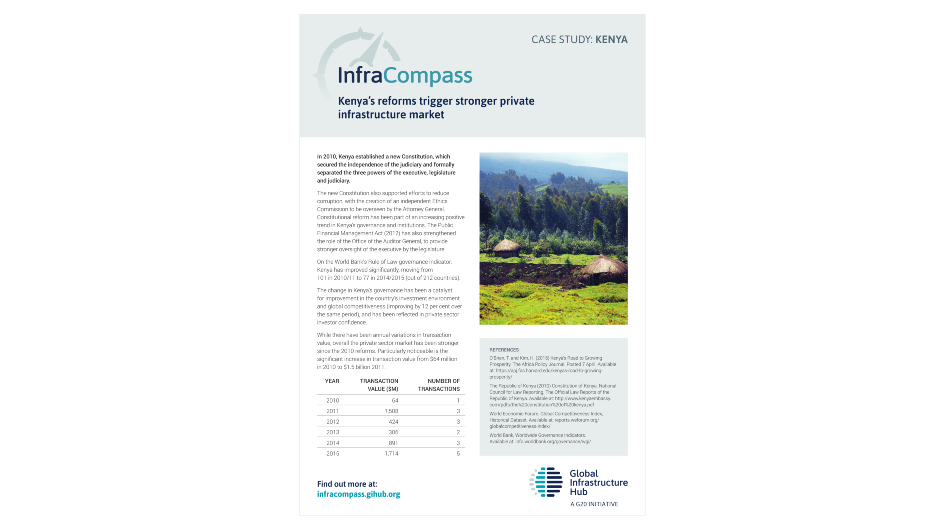283 results found
Featured results

More results
This report reviews experiences with strategic infrastructure planning with a view to identifying international best practices.
The Indian government sought to construct a total of 200,000km of national highways by 2022, which required significant private investment
The Brazilian government sought to diversify its energy mix and planned to add c. 10GW of power from renewable sources to its national grid by 2018
The USD 700 million Paseo del Bajo project is a transformative road corridor project being developed by the City of Buenos Aires (CABA) in Argentina to ease traffic and improve connectivity between the North and South areas of the city.
Star Ratings provide an evidence-based objective measure of crash risk to ensure that safety is built-in to designs for upgrades and new roads prior to construction.
Most public infrastructure investments in the US are made by individual states rather than the federal government
The São Paulo government sought to expand the a 720km NE-SW road across the state of São Paolo, which had one of the highest traffic volumes in the country
The International Finance Corporation (IFC) has a mandate to mobilize private financing and is looking to do this through various syndicated products including: B Loans, Parallel Loans and A Loan Participations
ChinaRAP is a collaboration between the International Road Assessment Programme and the Research Institute of Highway (RIOH), Ministry of Transport (MoT). Launched in 2008, seed financial support was provided through the World Bank Global Road Safety Facility by Bloomberg Philanthropies and now ten times that amount is now mobilised by the Chinese Government.
This analysis was drawn from the GI Hub's InfraCompass tool. The case study reflects on how Colombia has undergone a long period of transition to become an emerging economy leader.
This analysis was drawn from the GI Hub's InfraCompass tool. The case study reflects on how change in Kenya's governance acted as a trigger to make it a stronger private infrastructure marlet.
This analysis was drawn from the GI Hub's InfraCompass tool. and the case study reflects information on how the reform of land registration in the Malaysian state of Sarawak took place.
The GBP 4.2bn Thames Tideway Tunnel ( TTT ) project, a 25km tunnel to run beneath the River Thames in the centre of London, is the largest sewer improvement project to be conducted in the UK for over a century.
Pacífico Tres was created in 2014 to facilitate the construction of a c. 150km highway linking three of Colombia's most commercially important regions
Japan's Program for Earthquake-Resistant School Buildings has increased the seismic safety of Japanese schools, and hence increased the safety of Japanese schoolchildren, teachers, and communities. Since 2003, when the program accelerated, the share of earthquake-resistant public elementary and junior high schools has increased, from under half of schools in 2002 to over 95 percent in April 2015. Japan is sharing knowledge from this program with developing countries through its relationship with the Global Facility for Disaster Reduction and Recovery (GFDRR), whose Global Program for Safer Schools has been supported by the Japan–World Bank Program for Mainstreaming Disaster Risk Management in Developing Countries and its implementing arm, the Disaster Risk Management Hub, Tokyo.
UN ESCAP supports governments in Asia-Pacific in implementing measures to efficiently involve the private sector in infrastructure development.
The Secretariat of the Program of Investment Partnerships (SPPI), together with the National Institute of Metrology, Quality and Technology (Inmetro), has prepared The Accreditation Program for the Inspection of Infrastructure Projects.
The report first gives background information on infrastructure prioritization in Panama, then follows with a description of the IPF in technical and implementation terms.
Australia's national government introduced policy to incentivize asset recycling by state-level governments, by offering up to 15% of the sale or lease proceeds of asset privatizations for re-investment in infrastructure projects





 Link
Link





